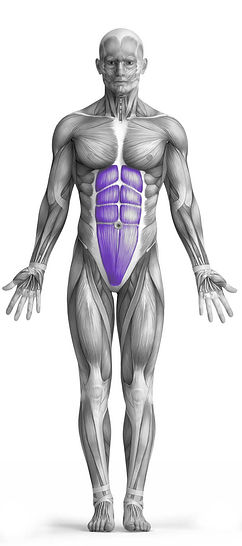Oblique Cable Crunch 101 Video Tutorial
0

Exercise Synopsis
Target Muscle Group
Abs
Secondary Targets
None
Execution
Isolation
Force Type
Pull
Required Equipment
Cable Machine
Fitness Level
Beginner
Variations
None
Alternatives
None
Timer
Hour
Minute
Second
Stopwatch
00:00:00:00
Overview
The Oblique Cable Crunch is an effective exercise that primarily targets the abdominal muscles, focusing on the obliques. This movement is performed using a cable machine, where the user pulls the cable while crunching the torso to the side, engaging the oblique muscles. The exercise helps improve core strength and stability by isolating the obliques, and it can be adjusted for intensity by changing the weight on the cable machine. Since it specifically targets the abs with minimal involvement of other muscle groups, it’s an excellent choice for those looking to refine their midsection and enhance core definition.
How to Perform
Begin by attaching a D-handle to the high pulley of a cable machine.
Kneel beside the machine with your knees bent at a 90-degree angle, positioning your body sideways to the cable.
Grasp the D-handle with the hand that is closest to the cable, holding it near your head with your forearm perpendicular to your upper arm. This will be your starting position.
Engage your core and initiate the movement by crunching your torso downward and diagonally toward the side, bringing your elbow toward your hip. Keep your hips stationary to avoid unnecessary movement.
Focus on using your oblique muscles to create the crunching motion, ensuring that the movement comes from your torso rather than just your arms.
After reaching the peak of the crunch, pause briefly, then slowly return to the starting position with control, maintaining tension in the cable throughout the movement.
Complete the desired number of repetitions on one side, then switch to the other side to work both obliques evenly.
★ Bonus: For exercises that involve external weights (such as dumbbells, barbells, or machines), the One Rep Max (1RM) calculator can help you estimate your maximum lifting capacity. Use it to track your strength progress and adjust your training for optimal results.
Tips
Attach a D-handle to a high pulley on a cable machine.
Kneel sideways next to the machine with your knees bent at 90 degrees.
Grip the handle with the arm closest to the cable and position your forearm at a right angle to your upper arm.
Engage your core and initiate the movement by crunching your torso downward and sideways.
Focus on using your obliques to perform the crunch, not your arms.
Keep your hips stable throughout the movement to avoid unnecessary shifting.
Pause briefly at the bottom of the movement for maximum muscle activation.
Slowly return to the starting position, maintaining control of the cable.
Perform the desired number of reps on one side before switching to the other side.
Maintain consistent tension on the cable for the entire set to effectively target the obliques.
How Not to Perform
Avoid Using Momentum: Do not jerk or swing your body to initiate the movement. Focus on controlled, deliberate movements to ensure the target muscles are engaged throughout the exercise.
Do Not Overextend Your Arms: Keep your forearm at a right angle to your upper arm to maintain proper alignment. Avoid extending your arms too far or letting your elbow move too far from your body.
Don’t Move Your Hips: Avoid shifting your hips or using them to assist in the crunch. The movement should be isolated to the torso to target the obliques effectively.
Don’t Rush the Movement: Avoid performing the exercise too quickly. Take your time to control both the contraction and the return phase, ensuring tension is maintained on the cable.
Don’t Allow Your Elbow to Lead: Your elbow should follow the natural movement of your torso, not the other way around. Let the obliques control the motion rather than relying on your arm to pull.
Avoid Overloading the Weight: Don’t use too much weight, as this can lead to poor form and unnecessary strain. Choose a weight that allows you to perform the exercise with proper control and technique.
Don’t Neglect Your Breathing: Avoid holding your breath during the exercise. Exhale as you crunch downward and inhale as you return to the starting position to ensure proper oxygen flow.
Don’t Forget to Engage Your Core: Failing to activate your core properly can reduce the effectiveness of the exercise. Make sure your abs are engaged throughout the movement to protect your lower back and maximize results.
Avoid Twisting Your Torso Too Much: While the exercise involves side bending, do not twist your torso excessively. Focus on a controlled crunch motion rather than rotating your body.
Don’t Skip the Pause at the Bottom: Avoid rushing through the lowest point of the crunch. Take a brief pause at the bottom to increase the time under tension and better target the oblique muscles.
Variations
Variations of fitness exercises refer to different ways of performing a specific exercise or movement to target various muscle groups, intensities, or goals. These variations aim to challenge the body differently, prevent plateaus, and cater to individuals with varying fitness levels.
Alternatives
Alternative exercises in fitness refer to different movements or activities that target similar muscle groups or serve the same training purpose as the primary exercise. These alternative exercises can be used as substitutes when the original exercise is unavailable or challenging to perform due to various reasons such as equipment limitations, injuries, or personal preferences.








